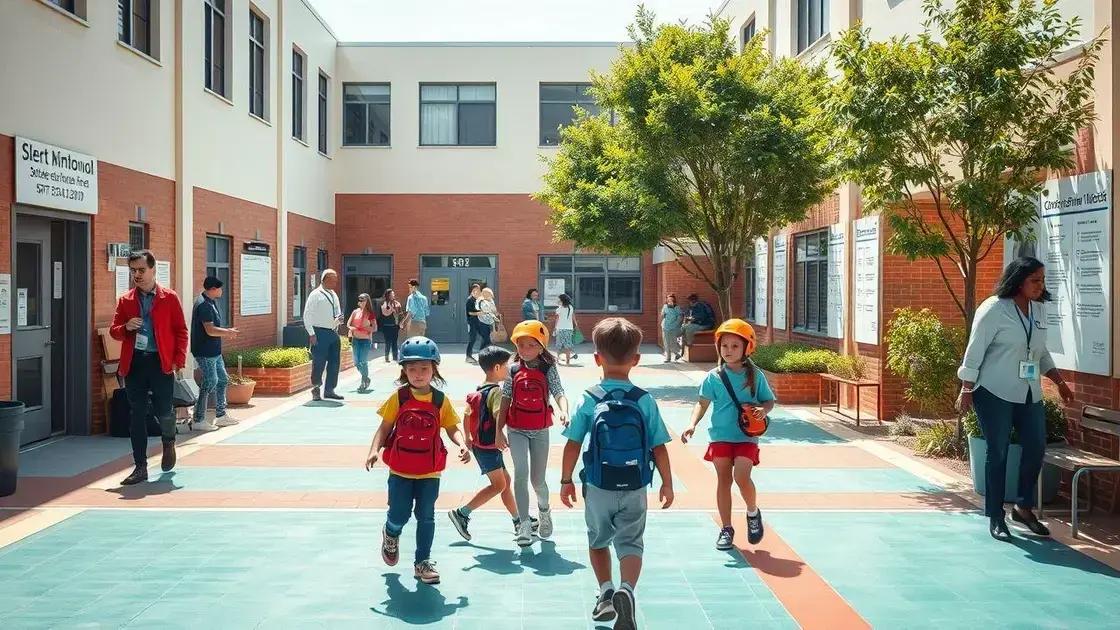Former school safety initiative: thriving programs that protect

The former school safety initiative focuses on enhancing student protection through technology, mental health support, and community engagement, addressing challenges like limited resources and evolving threats effectively.
The former school safety initiative has led to innovative approaches that foster safer environments for students. Have you noticed how some schools have become remarkably secure? Let’s dive into these transformative programs.
Understanding the former school safety initiative
The former school safety initiative has become crucial in today’s educational landscape. Schools have prioritized student safety, leading to innovative solutions that address various challenges. As we explore this initiative, it’s important to understand its core components and objectives.
Core Principles of the Initiative
The initiative is built on several core principles that guide its implementation. These principles include a focus on community involvement, comprehensive safety training, and the use of modern technology.
- Community involvement: Engaging parents and local organizations fosters a supportive environment.
- Safety training: Regular safety drills ensure that students and staff know how to respond in emergencies.
- Use of technology: Surveillance cameras and alert systems enhance security measures.
Another vital aspect of the initiative is its adaptability. Schools must tailor safety measures to fit their unique environments. This flexibility allows institutions to tackle specific threats effectively while promoting student well-being. Additionally, ongoing assessment plays a key role in this process. Regular evaluations help schools identify areas that need improvement.
Benefits of the Initiative
Implementing the former school safety initiative brings numerous benefits. Firstly, it promotes a positive school climate, making students feel secure and focused on learning. When students perceive their environment as safe, they are more likely to engage actively in their education. Furthermore, the initiative cultivates collaboration among school staff, parents, and local authorities. This teamwork is essential for developing effective safety plans.
Moreover, data-driven decision-making enhances the efficiency of safety programs. Schools rely on statistics and feedback to refine their strategies. This ensures that the measures in place are effective and responsive to changing circumstances. Overall, understanding the former school safety initiative enables schools to create safer and more supportive learning environments for all students.
Key components of successful safety programs
The key components of successful safety programs are essential for fostering a secure educational environment. Understanding these components can help schools implement effective strategies to protect students and staff. Each component plays a vital role in enhancing overall safety.
1. Strong Leadership
A successful safety program begins with strong leadership from school administrators. They set the tone and prioritize safety as a core value. When leaders support safety initiatives, it encourages staff and students to take them seriously.
2. Comprehensive Training
Training is another crucial aspect of successful safety programs. Regular training sessions for teachers and staff ensure everyone knows their roles during emergencies. This training covers various scenarios, from natural disasters to intruder situations.
- Emergency response drills: Conducting drills helps prepare everyone for real situations.
- First aid training: Teachers trained in first aid can provide immediate assistance.
- Communication training: Effective communication during emergencies can save lives.
In addition, communication plays a critical role in safety programs. Schools must establish clear channels for reporting safety concerns. This empowers students and staff to speak up without fear.
3. Engaging the Community
Another vital component is community engagement. Schools should involve parents, local law enforcement, and mental health professionals in safety planning. By collaborating with community members, safety programs can be more effective and responsive to local needs.
Finally, evaluating the program regularly is essential. Schools should assess their safety protocols to identify strengths and weaknesses. This ongoing assessment allows for continuous improvement and adaptation to new challenges. By focusing on these key components, schools can create successful safety programs and ensure a secure environment for learning.
Impact of initiatives on student well-being

The impact of initiatives on student well-being is profound and far-reaching. Schools that implement safety initiatives not only enhance security but also create a positive environment that supports learning and growth. When students feel safe, they are more likely to thrive academically and socially.
Positive Mental Health
One of the most significant benefits of safety initiatives is their contribution to positive mental health. Students who know their safety is prioritized experience less anxiety and fear. This leads to improved focus on studies and better overall performance.
Building Trust and Relationships
Safety initiatives foster trust among students, teachers, and parents. When schools communicate openly about safety measures, they build stronger relationships within the community. Students are more likely to feel valued and supported, promoting a sense of belonging.
- Peer interaction: Improved safety enhances peer relationships, making it easier for students to connect.
- Teacher support: A safe environment encourages teachers to provide emotional support, enhancing student confidence.
- Community engagement: Parental involvement increases, leading to a supportive school atmosphere.
Moreover, the initiatives create a culture of respect and responsibility. Students learn the importance of caring for one another’s well-being. This not only contributes to a peaceful school environment but also prepares them for future interactions in the wider community.
Enhanced Academic Performance
Another important aspect is the correlation between safety and academic success. When students feel secure, they can concentrate better on their studies. Research shows that schools with strong safety measures often report higher test scores and improved attendance rates.
The psychological benefits of a secure learning environment can’t be underestimated. Students are more willing to participate in classroom activities, ask questions, and engage with their peers. All these factors contribute to a robust educational experience that promotes both personal and academic development.
Challenges faced in school safety efforts
The challenges faced in school safety efforts are complex and require careful consideration. While many schools strive to create safe environments, various obstacles can hinder these efforts. Identifying these challenges is the first step towards developing effective solutions.
1. Limited Resources
One major challenge is limited funding and resources. Many schools operate under tight budgets, making it difficult to implement comprehensive safety measures. Schools often find it hard to allocate money for advanced security systems or staff training when basic needs are not met.
2. Communication Gaps
Another significant issue is communication gaps among stakeholders. Effective safety procedures require coordination between school staff, parents, and local authorities. When communication is unclear or inconsistent, it can lead to misunderstandings and inadequate responses in emergencies.
- Inadequate training: Staff may not receive proper training, impacting their ability to respond in crises.
- Misunderstanding roles: If everyone doesn’t know their responsibilities, chaos can ensue during emergencies.
- Parent involvement: Lack of engagement from parents can weaken safety efforts at home as well.
Additionally, there are resistance and fear of change among school communities. New safety initiatives may face skepticism from students, parents, and staff. Some individuals may feel uncomfortable with enhanced security measures, perceiving them as overbearing or intrusive.
3. Evolving Threats
Finally, the nature of threats to school safety is constantly evolving. Issues like bullying, mental health crises, and external violence require schools to adapt quickly. Keeping up with these challenges can be overwhelming for administrators, who must constantly assess and update their strategies.
Furthermore, the stigma surrounding mental health often prevents schools from addressing the needs of at-risk students effectively. Support systems need to be in place, yet many schools struggle to provide adequate mental health resources for students. By addressing these challenges, schools can strengthen their safety efforts and create a better environment for all students.
Future trends in school safety improvement
The future trends in school safety improvement are shaping how educational institutions approach safety. As technology and methodologies evolve, schools are adopting innovative strategies to create safe learning environments. Staying informed about these trends can help schools prepare for upcoming challenges.
1. Enhanced Use of Technology
One significant trend is the increased use of technology in safety measures. Schools are integrating advanced surveillance systems and security applications to monitor their environments more effectively. Artificial intelligence is being utilized to analyze security footage and identify potential threats in real time.
2. Mental Health Support Integration
Another important trend involves integrating mental health support into school safety plans. Recognizing that a student’s mental well-being is crucial to safety, schools are focusing more on providing resources such as counseling and mental health education. Increasing access to these services can directly reduce incidents related to emotional distress.
- Support groups: Establishing peer support groups can foster a community of care.
- Training staff: Educating teachers on mental health issues can lead to early interventions.
- Workshops: Hosting workshops on emotional resilience can empower students to handle stress better.
Moreover, collaboration with local mental health organizations is becoming more common. This partnership helps schools access expert resources while creating a more comprehensive safety plan.
3. Focus on Community Engagement
Future trends also indicate a shift towards stronger community engagement in safety efforts. Schools are realizing the value of involving parents, local businesses, and law enforcement in their safety discussions. Building a supportive community around schools can create a safer environment for everyone.
Additionally, schools are hosting community meetings to gather input and enhance safety policies. These collaborative efforts can lead to a more inclusive approach that addresses the unique needs of each community. By embracing these trends, schools can build a proactive safety culture, ensuring that the environment remains secure for all students.
In summary, improving school safety is a continuous journey that requires collaboration, innovation, and adaptability. By embracing new technologies, integrating mental health support, and fostering community engagement, schools can create safer environments for students to thrive. Addressing challenges such as funding limitations and evolving threats is essential for building effective safety programs. As we look to the future, being proactive and engaged in these efforts will ensure that schools remain places of learning and growth.
\n
| Topic | Details |
|---|---|
| 💡 Innovation | Embracing technology for better safety monitoring. |
| 🧠 Mental Health | Integrating support services directly into safety plans. |
| 🤝 Community | Building partnerships with parents and local organizations. |
| 📊 Resources | Focusing on securing funding to support safety initiatives. |
| 🔄 Adaptability | Responding to evolving threats and challenges effectively. |
\n
FAQ – Frequently Asked Questions about School Safety Initiatives
What are the key components of successful safety programs?
Key components include strong leadership, comprehensive training, effective communication, and community involvement.
How does technology enhance school safety?
Technology improves school safety through advanced surveillance systems, safety apps, and artificial intelligence monitoring.
Why is mental health support important in school safety?
Mental health support addresses student well-being, reducing crises and promoting a safer, more supportive environment.
What challenges do schools face in improving safety?
Challenges include limited funding, communication gaps, resistance to change, and evolving threats to safety.






